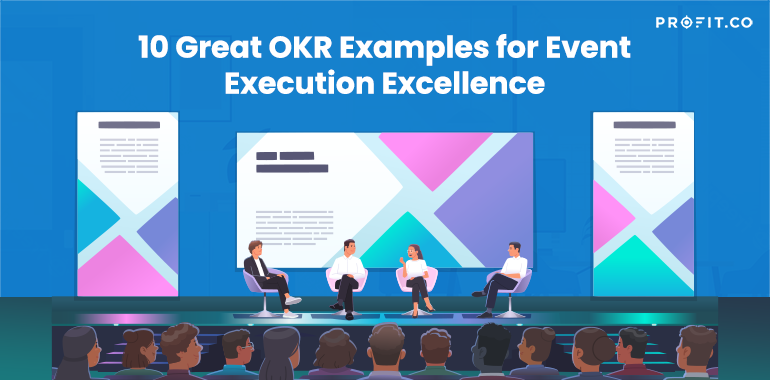From grand galas to cozy meet-ups, every event is a mission! But success isn’t just about crossing things off a list—it’s about aligning with the bigger picture. For event planners and organizers, achieving success goes beyond just checking off tasks; it’s about ensuring that the event aligns with broader strategic goals and provides tangible results. This is where OKRs, or Objectives and Key Results, come into play. This goal-setting framework, commonly adopted by tech giants and startups, can also be valuable in event management. With OKRs, your event’s vision gets crystal clear, and results? Undeniably measurable. With OKRs, event organizers can delineate their significant objectives for an event and break them down into quantifiable results. Utilizing OKRs ensures events drive value and align with broader organizational goals.
Building on that foundation, we’ve curated a collection of ready-to-use OKR examples tailored specifically for event execution excellence. Recognizing the distinct phases of event management, our OKRs are thoughtfully segmented to cater to pre-event planning, in-event operations, and post-event assessments. To help illustrate this, Let’s explore this new venture with an example from the tech conference world! With these examples, you’ll be equipped to ensure every stage of your event resonates with purpose and precision.
Pre-Events
Pre-events set the stage for the main affair, acting as crucial touchpoints to build anticipation and ensure everything runs smoothly on the big day. Properly executed, they can amplify attendee engagement and streamline logistical hurdles.

Example 1
Events are strategic avenues to bolster the sales pipeline, drive potential leads, and foster client relationships. Setting the objective of improving sales impact through in-person events aligns the team’s efforts toward creating valuable opportunities. By focusing on generating qualified leads and consistently organizing events, the organization aims to maximize the potential of its sales pipeline, fostering better client relationships and driving growth.
Objective : Increase pipeline through in-person events
KR 1 : Increase qualified leads generated from in-person events from 20% to 30%
KR 2 : Generate 50 MQL per event
KR 3 : Conduct at least 5 in-person events per quarter
 Objective
Objective
Increase pipeline through In-person Events
Target Date: Q3-2023
Visibility: All Employees
 Key Results
Key Results
Increase qualified leads generated from in-person events from 20% to 30%.

Generate 50 MQL per event.

Conduct at least 5 in-person events per quarter

Example 2
Maximizing event scale and outreach ensures a broader audience engagement and amplifies brand visibility. The objective to expand the reach and impact of an event is about capturing a larger audience and enhancing the event’s overall influence. By improving registrations and leveraging targeted marketing, the organization aims to ensure that its events have a more significant presence, leading to increased engagement, participation, and brand recognition.
Objective : Expand the size and reach of the event
KR 1 : Increase event registrations from 70% to 80%
KR 2 : Achieve a 15% increase in registrations from targeted marketing campaigns
KR 3 : Improvement in referral registrations from 70 % to 90%
 Objective
Objective
Expand the size and reach of the event
Target Date: Q3-2023
Visibility: All Employees
 Key Results
Key Results
Increase event registrations from 70% to 80%

Achieve a 15% increase in registrations from targeted marketing campaigns

Improvement in referral registrations from 70 % to 90%

Example 3
Focusing on delivering compelling event content aims to create meaningful experiences for attendees. By enhancing attendee satisfaction, increasing organic search traffic, and securing industry expert speakers, the organization strives to ensure that every event leaves a lasting impact and provides valuable insights to participants.
Objective : Deliver high-quality event content
KR 1 : Increase post-event satisfaction score from 4.0 to 4.5 from the attendees
KR 2 : Increase organic search traffic to event content from 20% to 40%
KR 3 : Secure at least three industry expert speakers for each event
KR 4 : Ensure that at least 85% of event attendees rate the content as highly relevant to their interests and needs
KR 5 : Conduct pre-event speaker training sessions for all events
 Objective
Objective
Deliver high-quality event content
Target Date: Q3-2023
Visibility: All Employees
 Key Results
Key Results
Increase post-event satisfaction score from 4.0 to 4.5 from the attendees

Increase organic search traffic to event content from 20% to 40%

Secure at least three industry expert speakers for each event

Ensure that at least 85% of event attendees rate the content as highly relevant to their interests and needs

Conduct pre-event speaker training sessions for all events

Example 4
The objective of enhancing event logistics and punctuality showcases the importance of seamless event execution. By achieving a high rate of session punctuality, ensuring timely distribution of event materials, and improving vendor reliability, the organization seeks to create a smoother event experience, resulting in increased satisfaction among attendees and stakeholders.
Objective : Enhance event logistics and operations
KR 1 : Achieve a 95% or higher rate of sessions and activities starting on time (measured by event schedules and attendee feedback)
KR 2 : Ensure 100% timely delivery of event materials for all attendees
KR 3 : Increase the percentage of on-time vendor deliveries from 63% to 80%
KR 4 : Reduce Event planning time from 30 days to 20 days
 Objective
Objective
Enhance event logistics and operations
Target Date: Q3-2023
Visibility: All Employees
 Key Results
Key Results
Achieve a 95% or higher rate of sessions and activities starting on time (measured by event schedules and attendee feedback)

Ensure 100% timely delivery of event materials for all attendees

Increase the percentage of on-time vendor deliveries from 63% to 80%

Reduce Event planning time from 30 days to 20 days

Example 5
Aiming to amplify event sponsorships involves focusing on revenue growth, strong conversion rates, and sponsor loyalty. The organization aims to foster valuable partnerships by achieving these key results, leading to increased financial support, wider exposure, and long-term relationships with sponsors.
Objective : Maximize event sponsorships
KR 1 : Increase the total sponsorship revenue from 15% to 25%
KR 2 : Achieve a 25% increase in sponsorship revenue, up from 15% compared to previous events
KR 3 : Achieve a sponsorship conversion rate of 40% or higher from initial leads or inquiries to signed sponsorship agreements
KR 4 : Maintain a sponsorship retention rate of 85% or higher, indicating ongoing satisfaction and value for returning sponsors
KR 5 : Increase the sponsor inquiries from 60% to 80% compared to previous events.
 Objective
Objective
Maximize event sponsorships
Target Date: Q3-2023
Visibility: All Employees
 Key Results
Key Results
Increase the total sponsorship revenue from 15% to 25%

Achieve a 25% increase in sponsorship revenue, up from 15% compared to previous events

Achieve a sponsorship conversion rate of 40% or higher from initial leads or inquiries to signed sponsorship agreements

Maintain a sponsorship retention rate of 85% or higher, indicating ongoing satisfaction and value for returning sponsors

Increase the sponsor inquiries from 60% to 80% compared to previous events.

Example 6
The objective of improving brand awareness aims to increase the organization’s visibility in the market. By driving more organic website visits, boosting post-event sales, and expanding the digital footprint, the organization aims to strengthen its brand presence, leading to greater brand recognition and loyalty.
Objective : Improve brand awareness
KR 1 : Increase website traffic from organic search from 30% to 50%
KR 2 : Achieve a 20% increase in post-event sales within 6 months of each event
KR 3 : Increase Referral traffic from 20% to 45% from other reputed platforms through positive word of mouth and brand recognition
KR 4 : Increase Social Media impressions from 40% to 60%
KR 5 : Achieve a total of at least 1,000 shares across various content pieces, such as blog posts, infographics, videos, and whitepapers
 Objective
Objective
Improve brand awareness
Target Date: Q3-2023
Visibility: All Employees
 Key Results
Key Results
Increase website traffic from organic search from 30% to 50%

Achieve a 20% increase in post-event sales within 6 months of each event

Increase Referral traffic from 20% to 45% from other reputed platforms through positive word of mouth and brand recognition

Increase Social Media impressions from 40% to 60%

Achieve a total of at least 1,000 shares across various content pieces, such as blog posts, infographics, videos, and whitepapers

During Events
During events, the spotlight is on seamless execution, maintaining a dynamic engagement level, and ensuring attendee satisfaction. It’s the culmination of meticulous planning, where real-time responsiveness becomes paramount. A well-managed event solidifies the brand’s reputation, fostering lasting impressions and relationships.

Example 7
Focusing on enhancing attendee engagement aims to create events that resonate with participants. By improving engagement scores, session ratings, and introducing innovative interactive elements, the organization seeks to ensure attendees have meaningful and memorable experiences.
Objective : Improve attendees’ satisfactory engagement
KR 1 : Increase the average attendee engagement score from 60% to 80%
KR 2 : Achieve an average session rating of 4.5 out of 5 or higher based on post-session survey feedback
KR 3 : Implement 3 interactive elements in 5 events per quarter
KR 4 : Improve live Poll response rate from 80% to 90%
 Objective
Objective
Improve attendees’ satisfactory engagement
Target Date: Q3-2023
Visibility: All Employees
 Key Results
Key Results
Increase the average attendee engagement score from 60% to 80%

Achieve an average session rating of 4.5 out of 5 or higher based on post-session survey feedback

Implement 3 interactive elements in 5 events per quarter

Improve live Poll response rate from 80% to 90%

Example 8
Optimizing event technology ensures a streamlined attendee experience and enhances engagement metrics. Leveraging the latest tools can elevate the event’s impact, making interactions more immersive and memorable. By encouraging participation through gamification, implementing contactless check-in, and enhancing interaction during simulative events, the organization aims to provide attendees with immersive and engaging event experiences.
Objective : Optimize event technology
KR 1 : Achieve a minimum participation rate of 70% of registered event attendees actively engaging in gamified activities throughout the event.
KR 2 : Implement contactless check-in system
KR 3 : Increase unique visitor count for simulative events from 50% to 75%
 Objective
Objective
Optimize event technology
Target Date: Q3-2023
Visibility: All Employees
 Key Results
Key Results
Achieve a minimum participation rate of 70% of registered event attendees actively engaging in gamified activities throughout the event.

Implement Contactless Check-in System

Increase unique visitor count for simulative events from 50% to 75%

Post Events
Post-events are a time for reflection, analysis, and feedback assimilation. It’s crucial to evaluate the event’s success metrics and gather insights for future improvements. Engaging with attendees post-event also fortifies relationships, ensuring lasting connections and loyalty.

Example 9
Maximizing event ROI ensures every dollar spent translates to tangible value, fostering business growth and enhancing brand reputation. The objective of maximizing event return on investment (ROI) emphasizes the importance of deriving substantial value from events. By increasing sales pipeline impact, boosting attendance, closing deals, and securing on-site meetings, the organization aims to ensure that events contribute significantly to business growth and success.
Objective : Maximize ROI of Events
KR 1 : Increase sales pipeline from event participation from $50k to $80K
KR 2 : Increase post-event attendees from 7% to 15%
KR 3 : Generate 10 closed deals directly attributed to the in-person event
KR 4 : Secure a minimum of 6 on-site sales meetings
 Objective
Objective
Maximize ROI of Events
Target Date: Q3-2023
Visibility: All Employees
 Key Results
Key Results
Increase sales pipeline from event participation from $50k to $80K

Increase post-event attendees from 7% to 15%

Generate 10 closed deals directly attributed to the in-person event

Secure a minimum of 6 on-site sales meetings

Example 10
We’re laser-focused on bolstering our post-event initiatives: The objective of enhancing post-event follow-up emphasizes the importance of maintaining connections and learning from each event. By focusing on conversion rates, sponsor engagement, future event interest, prompt follow-ups, and attendee feedback, the organization aims to gather valuable insights and build lasting relationships with attendees and sponsors for continuous improvement.
Objective : Improve post-event follow-up
KR 1 : Increase the conversion rate of post-event follow-up actions from 30% to 50%
KR 2 : Obtain a post-event engagement rate of 70% or higher from sponsors
KR 3 : Increase interest in future events from 5% to 15%
KR 4 : Achieve a feedback response rate of 50% or higher from event attendees, gathering valuable insights for future improvements
 Objective
Objective
Improve post-event follow-up
Target Date: Q3-2023
Visibility: All Employees
 Key Results
Key Results
Increase the conversion rate of post-event follow-up actions from 30% to 50%

Obtain a post-event engagement rate of 70% or higher from sponsors

Increase interest in future events from 5% to 15%

Achieve a feedback response rate of 50% or higher from event attendees, gathering valuable insights for future improvements

Conclusion
In the world of event planning, where the spotlight shines bright and margins for error are slim, leveraging OKRs is like having a backstage crew ensuring every performance is impeccable. From honing your event’s overarching vision to measuring its real-world impact, OKRs elevate the planning process into a strategic masterpiece. As we’ve seen with our tech conference example, this approach sets the stage for success and orchestrates an experience that resonates, delivers value, and aligns seamlessly with organizational ambitions. For any event planner eyeing the next big success, adopting OKRs is the standing ovation you’ve been waiting for!
